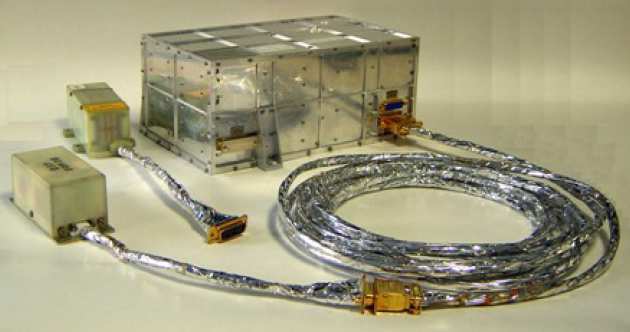Objective
 To provide magnetic field measurements of the Earth's magnetosphere from a few tens of nT in the outer magnetosphere to over 30,000nT at perigee.
To provide magnetic field measurements of the Earth's magnetosphere from a few tens of nT in the outer magnetosphere to over 30,000nT at perigee.
Key drivers
To provide an instrument that can survive the tough radiation environment of the mission, using parts without export restrictions to China.
Radiation Tolerance
- Magnetometer design: 100krad total dose tolerant with box providing 3.2mm Al shielding
| Double Star Magnetometer Key Performance Criteria | |
|---|---|
| Measurement Ranges | ±32764nT, ±8192nT, ±2048nT ±512nT, ±128nT |
| Resolution in highest range, ±32764nT | 4nT |
| Resolution in lowest range, ±128nT | 15pT |
| Outboard sensor: Noise density at 1Hz for temperature range -35ºC to 25ºC | <5pT/√Hz |
| Outboard sensor: Offset Drift between -35ºC and 25ºC | <0.03nT/ºC |
| Outboard sensor: Scale Factor Drift between -35ºC and 25ºC | <0.05% |
Both Double Star Spacecraft carry a dual-sensor fluxgate magnetometer instrument, sampling the ambient magnetic field along the orbit trajectory in the frequency range DC to 10Hz. The instrument consists of two tri-axial fluxgate sensors and an electronics box.
In order to minimise magnetic interference from the spacecraft itself, the magnetometer sensors are mounted at the tip, and inwards (0.5m from tip), of a 3.1m radial boom. The control electronics is housed inside a box on the Spacecraft MEP (Main Equipment Platform). Both OB (Outboard) and IB (Inboard) sensors are connected to the Electronics Box via a lightweight harness. The Electronics Box houses the instrument power and sense electronics controlled by a central DPU (Data Processing Unit).
The Double Star Magnetometer was designed and built by a team of engineers and scientists at three European institutes:
-
Space & Atmospheric Physics Group of Imperial College London, U.K.
-
Space Research Institute (Institut für Weltraumforschung, IWF) of the Austrian Academy of Sciences in Graz.
-
Institute for Geophysics and Extraterrestrial Physics (IGeP) of the Technical University Braunschweig, Germany.
See design overview for a block diagram showing the contributions from each institution.
Further Information:
Useful Links
DoubleStar Links: